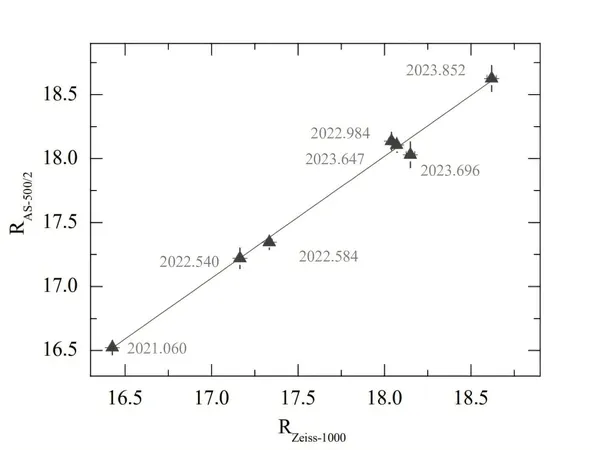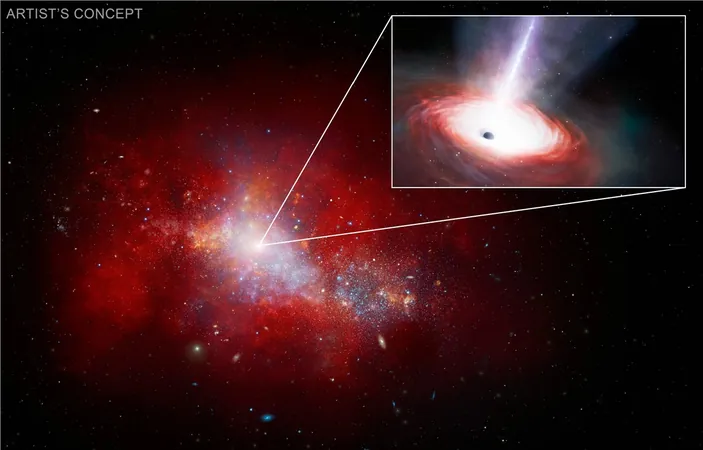
Unraveling the Mysteries of Blazar AO 0235+164: What Astronomers Discovered After Decades of Observation!
2024-11-12
Author: Sarah
Introduction
In a groundbreaking study released on November 3, astronomers have delved deep into the long-term variability of the fascinating blazar known as AO 0235+164. This multiwavelength research brings to light new insights into the behavior of this highly variable cosmic phenomenon, which is located a staggering 7.5 billion light-years away in the constellation Aries.
What are Blazars?
Blazars are among the most enigmatic objects in the universe, representing a type of quasar that is intensely compact, directly linked to supermassive black holes (SMBHs) at the cores of massive elliptical galaxies. Often regarded as the most prevalent extragalactic sources of gamma rays, these celestial bodies are characterized by their powerful relativistic jets that point almost straight at Earth.
Classification of Blazars
Astronomers classify blazars into two primary categories based on their optical emission characteristics: flat-spectrum radio quasars (FSRQs), marked by broad optical emission lines, and BL Lacertae objects (BL Lacs), which lack such features. AO 0235+164, identified as a BL Lac in 1975, has been the subject of intense scrutiny over the years, revealing remarkable fluctuations in non-thermal radiation across the full electromagnetic spectrum on timescales ranging from mere hours to several years.
Research Study Details
The researchers, led by Valery V. Vlasyuk from the Special Astrophysical Observatory (SAO) in Russia, meticulously analyzed nearly three decades' worth of multiwavelength data collected from various SAO telescopes. Their findings paint a vivid picture of the blazar's long-term behavior: "We present a study of the multiwavelength variability of the blazar AO 0235+164 based on the radio-to-gamma-ray data covering a long time period from 1997 to 2023," the authors noted.
Key Findings
A significant revelation from this study is the detection of a time lag that seems to decrease with frequency, spanning a range from 0 to 450 days. This trend, best described by a linear relationship with a negative slope, suggests that higher-energy emissions originate closer to the supermassive black hole, while lower-energy emissions are delayed, passing through more distant regions of the jet.
Variability Observations
Interestingly, the researchers observed a smooth decline in variability timescale transitioning from radio waves to gamma rays. During periods when AO 0235+164 exhibited low activity between 2009 and 2014, the most pronounced fluctuations in flux density—30% in the R-band and 50% in gamma rays—were recorded. The team hypothesizes that these variations resulted from interactions among shock remnants from significant outbursts emanating from the blazar.
Conclusion
As astronomers continue to unlock the secrets of blazars, AO 0235+164 stands out as a beacon of study, offering peeks into the complex dynamics at play near supermassive black holes. What else might the cosmos reveal to us in the ongoing exploration of these extraordinary objects? Stay tuned for more astronomical breakthroughs that could reshape our understanding of the universe!
Stay curious and keep an eye on the skies—who knows what cosmic wonders we will uncover next!




 Brasil (PT)
Brasil (PT)
 Canada (EN)
Canada (EN)
 Chile (ES)
Chile (ES)
 España (ES)
España (ES)
 France (FR)
France (FR)
 Hong Kong (EN)
Hong Kong (EN)
 Italia (IT)
Italia (IT)
 日本 (JA)
日本 (JA)
 Magyarország (HU)
Magyarország (HU)
 Norge (NO)
Norge (NO)
 Polska (PL)
Polska (PL)
 Schweiz (DE)
Schweiz (DE)
 Singapore (EN)
Singapore (EN)
 Sverige (SV)
Sverige (SV)
 Suomi (FI)
Suomi (FI)
 Türkiye (TR)
Türkiye (TR)